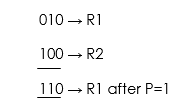Micro-Operations
The operations executed on data stored in registers are called micro-operations. A micro-operation is an elementary operation performed on the information stored in one or more registers.
Example: Shift, count, clear and load.
Types of Micro-Operations
The micro-operations in digital computers are of 4 types:
Register transfer micro-operations transfer binary information from one register to another.
1)Arithmetic micro-operations perform arithmetic operations on numeric data stored in registers
2)Logic micro-operations perform bit manipulation operation on non-numeric data stored in registers.
3)Shift micro-operations perform shift micro-operations performed on data.
Arithmetic Micro-Operations
Some of the basic micro-operations are addition, subtraction, increment and decrement.
Add Micro-Operation
It is defined by the following statement:
R3 → R1 + R2
The above statement instructs the data or contents of register R1 to be added to data or content of register R2 and the sum should be transferred to register R3.
Subtract Micro-Operation
The above statement instructs the data or contents of register R1 to be added to data or content of register R2 and the sum should be transferred to register R3.
Subtract Micro-Operation
In subtract micro-operation, instead of using minus operator we take 1's compliment and add 1 to the register which gets subtracted, i.e R1 - R2 is equivalent to R3 → R1 + R2' + 1
Increment/Decrement Micro-Operation
Increment and decrement micro-operations are generally performed by adding and subtracting 1 to and from the register respectively.
R1 → R1 + 1
R1 → R1 – 1
Symbolic Designation Description
R1 → R1 – 1
Symbolic Designation Description
R3 ← R1 + R2 Contents of R1+R2 transferred to R3.
R3 ← R1 - R2 Contents of R1-R2 transferred to R3.
R2 ← (R2)' Compliment the contents of R2.
R2 ← (R2)' + 1 2's compliment the contents of R2.
R3 ← R1 + (R2)' + 1 R1 + the 2's compliment of R2 (subtraction).
R1 ← R1 + 1 Increment the contents of R1 by 1.
R1 ← R1 - 1 Decrement the contents of R1 by 1.
Logic Micro-Operations
These are binary micro-operations performed on the bits stored in the registers. These operations consider each bit separately and treat them as binary variables.
Let us consider the X-OR micro-operation with the contents of two registers R1 and R2.
P: R1 ← R1 X-OR R2
In the above statement we have also included a Control Function.
Assume that each register has 3 bits. Let the content of R1 be 010 and R2 be 100. The X-OR micro-operation will be:

Shift Micro-Operations
These are used for serial transfer of data. That means we can shift the contents of the register to the left or right. In the shift left operation the serial input transfers a bit to the right most position and in shift right operation the serial input transfers a bit to the left most position.
There are three types of shifts as follows:
a) Logical Shift
It transfers 0 through the serial input. The symbol "shl" is used for logical shift left and "shr" is used for logical shift right.
In the above statement we have also included a Control Function.
Assume that each register has 3 bits. Let the content of R1 be 010 and R2 be 100. The X-OR micro-operation will be:

Shift Micro-Operations
These are used for serial transfer of data. That means we can shift the contents of the register to the left or right. In the shift left operation the serial input transfers a bit to the right most position and in shift right operation the serial input transfers a bit to the left most position.
There are three types of shifts as follows:
a) Logical Shift
It transfers 0 through the serial input. The symbol "shl" is used for logical shift left and "shr" is used for logical shift right.
R1 ← she R1
R1 ← she R1
The register symbol must be same on both sides of arrows.
b) Circular Shift
This circulates or rotates the bits of register around the two ends without any loss of data or contents. In this, the serial output of the shift register is connected to its serial input. "cil" and "cir" is used for circular shift left and right respectively.
c) Arithmetic Shift
This shifts a signed binary number to left or right. An arithmetic shift left multiplies a signed binary number by 2 and shift left divides the number by 2. Arithmetic shift micro-operation leaves the sign bit unchanged because the signed number remains same when it is multiplied or divided by 2.
R1 ← she R1
The register symbol must be same on both sides of arrows.
b) Circular Shift
This circulates or rotates the bits of register around the two ends without any loss of data or contents. In this, the serial output of the shift register is connected to its serial input. "cil" and "cir" is used for circular shift left and right respectively.
c) Arithmetic Shift
This shifts a signed binary number to left or right. An arithmetic shift left multiplies a signed binary number by 2 and shift left divides the number by 2. Arithmetic shift micro-operation leaves the sign bit unchanged because the signed number remains same when it is multiplied or divided by 2.
No comments:
Post a Comment